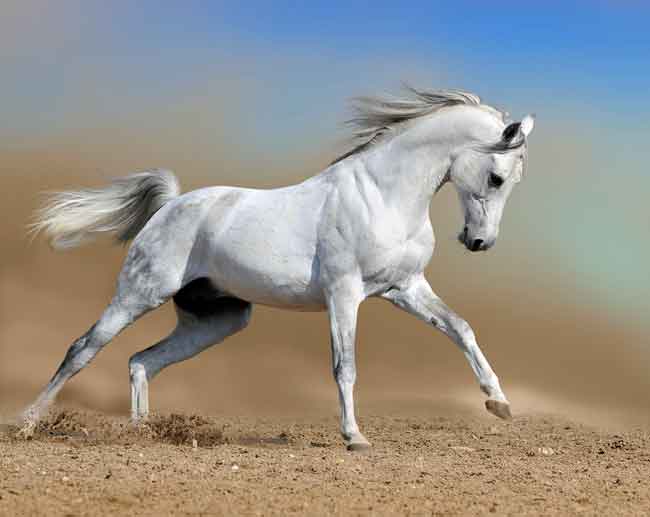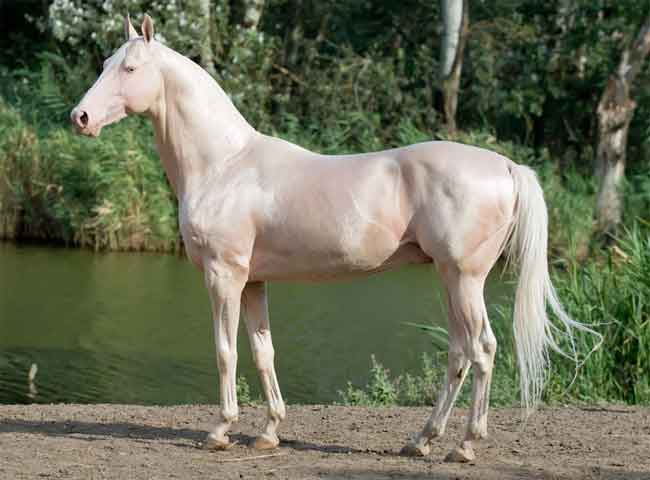White horses are very beautiful and popular. Where do you find the white horses and which horse breeds are most often white?
Let’s take a closer look at when white horses occur and how common they are.
Let’s start out with the one true white horse breed out there. Most white horses out there are not from a specific breed but the Camarilla horses are often white.
The Camarillo White Horse Breed

We do actually find one specific white horse breed. The Camarillo White Horses are almost always completely white horses. It’s one of the newer horse breeds in America as it only dates back around a hundred years.
It’s a very famous breed and it has often been written by famous people such as Ronald Reagan and various movie stars.
They are compact and really strong animals and they are great with humans. They all date back to one single horse called “Sultan”. It was a Spanish Mustang that was born in 1912.
Other than this breed, there aren’t any specific breeds of horses that are always white. A truly white horse is typically a genetic thing that happens once in a while but normally cannot be attributed to a specific breed.
That being said, there are some breeds that have been known to more often produce white horses than others.
Most white horses are actually light gray and will become more and more white over the years as they tend to “grey out”.
4 Types Of White Horses
There are several reasons why some horses are completely white. We will look at each of the reasons here and explain how and why this phenomenon arises.
1) Grey Horses That Eventually Turn White

The most common reason we see white horses is because they have grey skin that turns white over the years. They are born with grey skin and as they grow older, the skin turns brighter and brighter.
They are not what we call “true white horses” and they will often be darker around the muzzle.
You will normally be able to detect gray or darker areas on the horse if it’s a grey horse. You will see this as smaller spots or larger areas if you examine the horse thoroughly.
The easiest way to know that a white horse is actually a gray horse is to look at the skin color. These horses will always have dark skin while the truly white horses we will look at next have pink skin.
These horses can also start out with a pretty dark coat and as they start shedding the coat will turn lighter and lighter. But it’s really rare to find a gray horse where each and every part of the coat has turned white. That will almost always be darker spots or hairs here and there among the white hairs.
2) Truly White Horses
The truly white horses have pigmented skin which means that they do not have any color pigment at all and therefore turn out to be white.
They will often have blue or dark eyes and pink skin under the white coat.
They are as beautiful as they are rare and they are born completely white in contrary to the gray horses that eventually turn white.
These horses are what we call “Dominant white”. It’s a pretty rare phenomenon and when it happens the horse will be completely white all over the body. It normally happens because one of the parents is also Dominant white. It very rarely skips a generation because this genetic color turns out to be superior to other colors.
It will also sometimes happen by random mutation and cause a horse with two “normal” colored parents to become a Dominant white.
These horses have mostly been studied among these breeds:
- Thoroughbreds
- Arabian horses
- Camarillo White horses
The truly white horses are often not as robust as other horses. They will more easily get burned by the sun and therefore they are more vulnerable than other horses.
3) Sabino Horses
Sabino pattering appears in horses as white spots. It’s a result of the Sabino 2 gene which you can test for with a DNA test. Whenever a horse has two copies of this Sabino 1 gene it will become completely white.
It will get one of these genes from each parent and as a result, it will have to Sabino 1 genes. They are often around ninety percent covered by pink skin and white coat.
You need a DNA test in order to know if your white horse is a truly white horse or is Sabino horse. That’s how much they are alike.
4) Cremello Horses

The Cremello horse is often white and it will always have a completely white mane and tail. They aren’t the result of a genetic combination of what is called “creme genes”.
The cream gene is a gene that is responsible for the colors of the horse’s coat. Not all horses have this gene and when they have two copies of this gene they become what we call a “Cremello horse”.
The Creamello horses are typically not completely white. They would have a light cream-colored coat which can be almost white. People have often mistaken the Cremello horses for being albino horses.
How Much Do White Horses Cost?
White horses can cost from $500 to 150,000, or more. The color is a secondary factor and the price is more often determined by breed, training, family history, and temperament.
It depends on a lot of factors like how white the horse is and whether it’s a true white or the Creamello etc. These horses tend to be more expensive than other horses but the really expensive white horses are that expensive for other reasons.
The Camarillo horses, which are actually a completely white horse breed, is another story. They are rarely for sale and if you are so happy to find one, you should expect to pay A LOT of money.
But we should also mention that color is not the primary factor to look for when we’re talking about the price of a horse. There are all that much more important things to look for such as training, temperament, parents, etc.
Do Albino Horses Exist?
“Albino” actually means “white” so, in one sense of the word, all-white horses are albino horses. But what we talk about albino animals, what we normally mean is an animal that lacks the color pigments completely.
In order to be a true albino animal, you will need red eyes because there will be no colors in the eye,s other than the red blood.
There have been mentions about this, but most experts will tell you that it’s impossible. When we talk about completely white horses they always have blue or brown eyes and never red eyes.
Today it’s common knowledge that albino horses do not exist but there are still several mentions of albino horses throughout literature. We even find occurrences of the term “albino horses” in the American quarter horse Association’s rules. They were referring to Cremellos and Perlinos with the term “albino”. But in 2002 this term was removed entirely from the records.